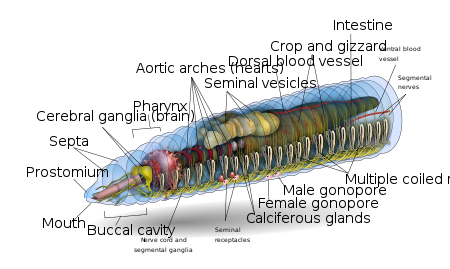Lumbricus terrestris
Lumbricus terrestris is a large, reddish worm species widely distributed around the world (along with several other lumbricids). In some areas where it is an introduced species, some people consider it a serious pest for outcompeting native worms. It has an unusual habit of copulating on the surface at night, which makes it more visible than most other earthworms.
| Lumbricus terrestris | |
|---|---|
 | |
| Scientific classification | |
| Kingdom: | |
| Phylum: | |
| Class: | |
| Order: | |
| Family: | |
| Genus: | |
| Species: | L. terrestris |
| Binomial name | |
| Lumbricus terrestris | |
Through much of Europe, it is the largest naturally occurring species of earthworm, typically reaching 20–25 cm in length when extended (though in parts of southern Europe, the native species are much larger).
Common names
Because it is widely known, Lumbricus goes under a variety of common names. In Britain, it is primarily called the common earthworm or lob worm (though the name is also applied to a marine polychaete). In North America, the term nightcrawler (or vitalis) is also used. In Canada, it is also called the dew worm, or "Grandaddy Earthworm". In several Germanic languages, it is called variants of "rain worm", for example in German Gemeiner Regenwurm ("common rain worm") or in Danish Stor regnorm ("large rain worm"). In the rest of the world, many references are just to the scientific name, though with occasional reference to the above names.
Although this is not the most abundant earthworm, even in its native range, it is a very conspicuous and familiar earthworm species in garden and agricultural soils of the temperate zone, and is frequently seen on the surface, unlike most other earthworms. It is also used as the example earthworm for millions of biology students around the world, even in areas where the species does not exist. However, 'earthworm' can be a source of confusion, since in most of the world, other species are more typical. For example, through much of the unirrigated temperate areas of the world, the "common earthworm" is actually Aporrectodea (=Allolobophora) trapezoides, which in those areas is a similar size and dark color to L. terrestris.
Biology

L. terrestris is an anecic worm. That is, it forms temporary deep burrows and comes to the surface to feed, as opposed to burrowing through the soil for its food as most other earthworms do. An unusual habit of this species is to pull leaves into the mouth of its burrow where they partially decay before being eaten. While they generally feed on plant material, they have been observed feeding on dead insects and feces.
The natural lifespan of L. terrestris is unknown, though individuals have lived for six years in captivity.
In parts of Europe, notably the Atlantic fringe of northwestern Europe, it is now locally endangered due to predation by the New Zealand flatworm (Arthurdendyus triangulatus) and the Australian flatworm (Australoplana sanguinea), two predatory flatworms accidentally introduced from New Zealand and Australia. These predators are very efficient earthworm eaters, being able to survive for lengthy periods with no food, so still persist even when their prey has dropped to unsustainably low populations. In some areas, this is having a seriously adverse effect on the soil structure and quality. The soil aeration and organic material mixing previously done by the earthworms has ceased in some areas.

As an invasive species in North America
L. terrestris is considered invasive in the north central United States. It does not do well in tilled fields because of pesticide exposure, physical injuries from farm equipment and a lack of nutrients.[1][2] It thrives in fence rows and woodlots and can lead to reductions in native herbaceous and tree regrowth.[3][4]
Further reading
- McTavish, Michael J.; Basiliko, Nathan; Sackett, Tara E. (December 2013). "Environmental Factors Influencing Immigration Behaviors of the Invasive Earthworm Lumbricus terrestris". Canadian Journal of Zoology. 91 (12): 859–865. doi:10.1139/cjz-2013-0153.
External links
- Kladivko EJ, Akhouri NM, Weesies G (1997). "Earthworm populations and species distributions under no-till and conventional tillage in Indiana and Illinois". Soil Biol Biochem. 29 (3–4): 613–615. doi:10.1016/s0038-0717(96)00187-3.
- Butt KR, Shipitalo MJ, Bohlen PJ, Edwards WM, Parmelee RW (1999). "Long-term trends in earthworm populations of cropped experimental watershed in Ohio, USA". Pedobiologia. 43: 713–719.
- Frelich LE, Hale CM, Scheu S, Holdsworth AR, Heneghan L, Bohlen PJ, Reich PB (2006). "Earthworm invasion into previously earthworm-free temperate and boreal forests". Biol Invasions. 8 (6): 1235–1245. doi:10.1007/s10530-006-9019-3. hdl:11299/175603.
- Hale CM, Frelich LE, Reich PB (2005). "Exotic European earthworm invasion dynamics in northern hardwood forests of Minnesota, USA". Ecol Appl. 15 (3): 848–860. doi:10.1890/03-5345.
| Wikimedia Commons has media related to Lumbricus terrestris. |
- "Types of Earthworms - New Zealand". Archived from the original on 24 May 2007.
- "Earthworm Research Group (at the University of Central Lancashire):Frequently Asked Questions". Archived from the original on 13 March 2009.
- "NNZ-Nightcrawler".
- "The microfungal community of Lumbricus terrestris middens in a Linden (Tilia cordata) forest" (PDF). Archived from the original (PDF) on 2 February 2019.
- "Exotic Earthworms in Minnesota Hardwood Forests" (PDF). Archived from the original (PDF) on 6 March 2004.
- Wise, Scott (2 September 2012). "Biologists trying to figure why giant earthworm grew so big". CBS 6, WTVR-TV. Retrieved 15 May 2013.